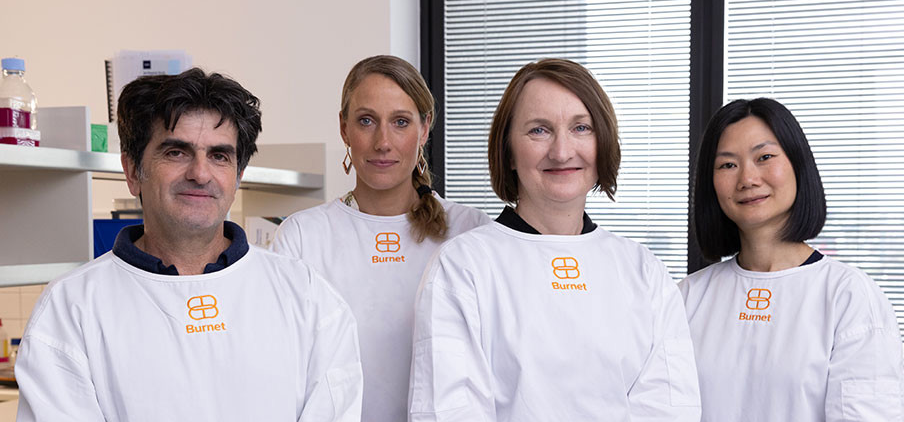Burnet Institute is one of Australia’s leading medical research and public health institutes.
We believe all people should have access to medical research and health programs, no matter who they are or where they live.
Since our beginnings at the Fairfield Hospital in 1986, we’ve developed our expertise in life sciences, public health and international development to drive better health outcomes for communities near and far.
Today, we’re working for a future where diseases are eliminated, where mothers and children are thriving, where the world is better prepared for health challenges, and where people are supported to reduce harms to their health.
Learn more about our strategy for greater impact in a rapidly changing world.
View our health themes, core programs and flagship initiatives.




Tap an image to expand it in focused view
Our vision
A more equitable world through better health.
Our purpose
To create and translate knowledge into better health, so no-one is left behind.
Our values
Respect, equality, inclusiveness, diversity.
—Professor Brendan Crabb AC, Director and CEO
How we work
Our approach is always collaborative, sustainable and locally led.
We’re the only medical research institute in Australia that’s also an accredited non-government organisation (NGO). This status represents the Australian Government’s confidence in our organisational effectiveness, governance and development programs.
Burnet is a global organisation, with offices in Australia, Papua New Guinea, Myanmar, Vanuatu – and operations all over the world.
Working towards health equity
Everything we do is grounded in health equity. Our focus is on improving the health and wellbeing of people who are at greater risk of poor health outcomes.
Burnet was founded during the HIV epidemic of the 1980s. Efforts to tackle HIV were hampered by the social stigma surrounding the groups most likely to be affected, especially gay men.
Today, just as then, we consult and work directly with people affected by the health issues we research. Explore some examples of our work with these key populations below.
- Every Yarn Counts was a campaign promoting hepatitis C testing and treatment in Aboriginal Community Controlled Health Organisations (ACCHOs). The campaign was co-designed with a National Reference Group (NRG) consisting of members from national, state, and local ACCHOs. It was implemented in 8 sites across 6 jurisdictions in Australia.
- During 2021 to 2024, Burnet partnered with Bulgarr Ngaru Medical Aboriginal Corporation and Australasian Society of HIV Medicine, Viral Hepatitis and Sexual Health Medicine in delivery and evaluation of a co-designed evidence-based blood borne virus (BBV) and sexually transmissible infections (STI) program. The program included staff education, prevention, testing, and treatment services in an Aboriginal Community Controlled Health Service in northern New South Wales. As a result, there was an improvement in staff knowledge of BBVs and STIs, and an increase in service level rates of testing and treatment.
- We supported and evaluated the early rollout of HIV PrEP among more than 8,000 gay and bisexual men enrolled in the PrEPX study, a large multi-state demonstration study.
- ACCESS is our world-leading surveillance system for blood borne viruses and sexually transmissible infections. It supports ongoing research including a large cohort study of more than 100,000 HIV-positive and -negative gay and bisexual men which provided evidence that HIV treatment-as-prevention achieved population-level declines in new HIV infections.
- Through our Sexual and Reproductive Health Integration Project in Papua New Guinea (PNG), we developed a standardised training manual for healthcare staff working with key populations (gay and bisexual men, transgender women and sex workers) in HIV and sexual health services. Over 250 healthcare workers received the training with the PNG National Department of Health endorsing its further roll-out.
- Our work with the Darebin Islamic community found that psychological wellbeing was a key priority following COVID-19. We co-designed videos and a facilitation guide to build mental health literacy and encourage conversations among Islamic leaders, young people and parents. The videos have received more than 17,000 views. Parents and young people participated in workshops run using the facilitation guide, with some enrolling in Mental Health First Aid courses to further their skills.
- We collaborated with the Centre for Multicultural Youth and Monash Action Lab to help young bicultural workers to lead research with their own communities. The bicultural workers ran discussions and workshops with over 50 young people from their communities and we co-designed program modules to develop leadership and facilitation skills among South Sudanese and Pasifika young people. Some modules have been added to in-school programs with and for multicultural young people.
- Our partnership with North East Multicultural Association and Today Design identified emergency communication preferences among multicultural communities in regional Victoria. We co-designed 3 videos to share people’s experiences and practical tips to empower multicultural communities to prepare for fires, floods and storms. These videos will be shared with multicultural communities in north-east Victoria to encourage greater emergency preparedness and build community connections.
- SuperMIX—the largest and longest running cohort study of people who inject drugs—contributed directly to the independent review of the Melbourne Supervised Injecting Room. The review found that the room attracts those most in need of the service and there were fewer overdoses requiring ambulance attendance.
- We worked with international research partners to deliver the first large-scale implementation of take-home naloxone in low- to middle-income countries. We showed that training people in take-home naloxone and overdose response is feasible and effective in these countries.
- Our data has provided definitive evidence of the need for high-coverage opioid agonist therapy and needle and syringe programs to prevent hepatitis C infections.
- Findings from our Prison and Transition (PATH) cohort study of men with injecting drug use histories being released from prison informed improved service delivery for men recently released from prisons in Victoria. The study formed the basis of The Forest, our co-designed holistic model of care for people leaving prison.
- Our work with the National Prisons Hepatitis Network and National Prisons Addiction Medicine Network produced national expert consensus recommendations for the management of hepatitis C and opioid substitution treatment in Australia’s prisons. The recommendations on hepatitis C management were the foundation for international guidelines and have influenced practice changes to improve care.
- We co-designed a support model with staff at First Nations-led arts organisation The Torch to help them engage artists in their in-prisons and community program while ensuring staff wellbeing is appropriately supported. The model was successfully implemented in the organisation, and we are further collaborating to evaluate the arts program and design systems that help staff measure, understand and describe the impact of their work.
- Our research on postpartum blood loss and the use of care bundles for postpartum haemorrhage has informed World Health Organization guidelines.
- We’ve supported midwifery education across Asia and the Pacific through projects including Pacific SMILE.
- We’ve supported women’s health with research targeting bacterial vaginosis, a common infection that can increase the risk of pregnancy complications and contracting other infections like HIV.
- Our Sex Drugs and Rock'n'Roll project has been collecting data to understand young people's health and behaviours for over 20 years. The data has informed policy decisions and been used to evaluate the impact of public health measures.
- We’ve influenced government policy with recommendations for the Online Safety Amendment (Social Media Minimum Age) Bill 2024 rooted in our research with young people.
- Healthy Minds Healthy Futures is a community-based model of mental health care that has reached 4550 young people in Myanmar. We trained 80 non-specialist health workers and community first-responders, trained 105 peer educators and reached over 3000 parents with interventions to improve parent support for youth mental health.
How we’re funded
Burnet is a not-for-profit organisation. We receive funding from a variety of competitive and non-competitive sources, including:
- state, federal and international governments
- non-government organisations
- philanthropic and commercial partnerships
- donations and bequests.
View our financial report in Annual and financial reports for more information.
Our future as part of the AIID
Burnet Institute is collaborating with The University of Melbourne and the Doherty Institute to establish The Australian Institute for Infectious Disease (AIID). Backed by the Victorian Government, the $650 million project aims to position Victoria as a global leader in infectious diseases and public health.
Feedback or complaints
Burnet is a member of the Australian Council for International Development (ACFID). ACFID is the peak body for Australian non-government organisations (NGOs) involved in international development and humanitarian action, working for a just, sustainable and equitable world. Burnet is committed to adhering to the ACFID Code of Conduct, demonstrating high standards of transparency and accountability. Find out more about the ACFID Code of Conduct. For any feedback or complaints, please contact feedback@burnet.edu.au. You can also view our complaints policy.
On this page
Our history
Burnet has been changing lives since 1986, but its origins can be traced back much further than that. Discover our history.
Our people and structure
How our organisation is structured, and the people behind it.
Annual and financial reports
View our annual and financial reports.
Policies, plans and strategies
Burnet is committed to the highest standards of governance in our research and workplace activities. Read our policies, action plans and our strategy.
Awards and scholarships
Explore Burnet Institute's most prestigious awards, including the Fenner Award and the Gust-McKenzie Medal.
Contact us
Find someone to contact at Burnet Institute.
Where we work
Burnet works with governments, researchers, regional NGOs and communities globally.
Reach for the many
What we mean by 'reach for the many,' our tagline.



